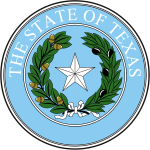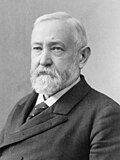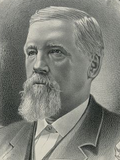1888 United States presidential election in Texas
| |||||||||||||||||||||||||||||||||
| Turnout | 22.27% of the total population | ||||||||||||||||||||||||||||||||
|---|---|---|---|---|---|---|---|---|---|---|---|---|---|---|---|---|---|---|---|---|---|---|---|---|---|---|---|---|---|---|---|---|---|
| |||||||||||||||||||||||||||||||||
 County Results
| |||||||||||||||||||||||||||||||||
| |||||||||||||||||||||||||||||||||
| Elections in Texas |
|---|
 |
|
|
The 1888 United States presidential election in Texas took place on November 6, 1888, as part of the 1888 United States presidential election. State voters chose 13 representatives, or electors, to the Electoral College, who voted for president and vice president.[2]
Texas was won by the incumbent President Grover Cleveland (D–New York), running with the former Senator and Chief Justice of the Supreme Court of Ohio Allen G. Thurman, with 65.70% of the popular vote, against former Senator Benjamin Harrison (R-Indiana), running with Levi P. Morton, the 31st governor of New York, with 24.73% of the vote and former Illinois state representative Alson Streeter (L–Illinois), running with Charles E. Cunningham, with 8.24% of the vote.[2]
The Prohibition Party ran brigadier general Clinton B. Fisk and John A. Brooks and received 1.33% of the vote.
Campaign
[edit]Members of the Knights of Labor and former members of the Greenback Party attended a convention in Waco on July 5, 1887, and formed an affiliate of the Union Labor Party. Around 300 delegates, mostly members of the Farmers' Alliance, from seventy counties attended a convention on May 15, 1888, to consider possible electoral campaigns. The delegates appointed Mayor H.S. Broiles as a one-man executive committee and he called for a Nonpartisan Convention to be held on July 2–3. The Nonpartisan Convention created a platform and slate of candidates. The ULP endorsed these candidates and platform and William R. Lamb, the chair of the Nonpartisan Convention, was given a seat on the ULP executive committee.[3]
Results
[edit]| 1888 United States presidential election in Texas[2] | ||||||||
|---|---|---|---|---|---|---|---|---|
| Party | Candidate | Running mate | Popular vote | Electoral vote | ||||
| Count | % | Count | % | |||||
| Democratic | Grover Cleveland of New York (incumbent) | Allen G. Thurman of Ohio | 234,883 | 65.70% | 13 | 100.00% | ||
| Republican | Benjamin Harrison of Indiana | Levi P. Morton of New York | 88,422 | 24.73% | 0 | 0.00% | ||
| Labor | Alson Streeter of Illinois | Charles E. Cunningham of Arkansas | 29,459 | 8.24% | 0 | 0.00% | ||
| Prohibition | Clinton B. Fisk of New Jersey | John A. Brooks of Missouri | 4,749 | 1.33% | 0 | 0.00% | ||
| Total | 357,513 | 100.00% | 13 | 100.00% | ||||
See also
[edit]References
[edit]Works cited
[edit]- Hild, Matthew (2015). "The Knights of Labor and the Third-Party Movement in Texas, 1886–1896". The Southwestern Historical Quarterly. 119 (1). Texas State Historical Association: 24–43. doi:10.2307/447112. JSTOR 24388910.




